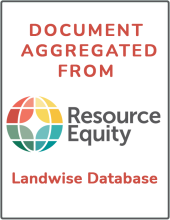Land Library Search
Through our robust search engine, you can search for any item of the over 73,000 highly curated resources in the Land Library.
If you would like to find an overview of what is possible, feel free to peruse the Search Guide.
/ library resources
Showing items 1 through 9 of 146.The findings of this study demonstrate that the despite the bouquet of land laws and other land reforms that have been put in place to make it easier for women to access land rights, both the formal and informal systems remain fraught with multiple extra-legal obstacles in the form of personal (f
Ordinary Malawians who live in customary land have been suffering from land grabbing due to their weak and ill-defined land rights.
The study aims to reveal the transition features of agricultural land use in the Groundnut Basin of Senegal from 2009 to 2018, especially the impact of urbanization on agricultural land and the viewpoint of farmland spatiotemporal evolution.
Land use/land cover (LULC) change driven by land use policy always leads to dramatic change in carbon storage and sequestration, especially in a rapidly urbanizing region.
One of the 34 themes of the spatial datasets of Directive 2007/2/EC INSPIRE is ‘land use’, rightly described independently of ‘land cover’. Laws in most countries, apart from the Netherlands, do not consider the electronic form of plans as a legally binding document.
Recent policies in China have encouraged rural-urban circular migration and an “amphibious” and flexible status of settlement, reacting against the recent risks of economic fluctuation in cities.
This paper is engaged with the critical perspective that highlights the role of the state in the production of urban informality by examining the dynamics of informal land-use practices in Dongguan, China since 1978.
Institutional setup in the land administration system plays a crucial role in the successful functioning of modern land administration. The institutional setup, whether separated for urban and rural land administration or unified, is responsible for implementing the legal and policy framework.
The paper analyzes the state and dynamics of key actors and institutions that regulate the use of resources within the protected areas of the North Caucasus, using the examples of the Teberda Biosphere Reserve and the Elbrus National Park.






